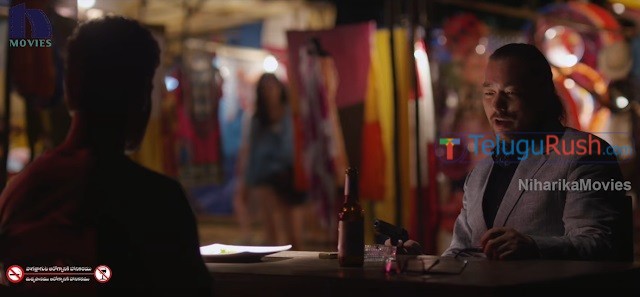1 Nenokkadine is a 2014 Telugu psychological thriller movie starring Mahesh Babu and Kriti Sanon in lead roles. Ram Achanta, Gopichand Achanta, and Anil Sunkara produced the film under 14 reels banner. Sukumar has written & directed the film. Please read 1 Nenokkadine movie review to know more about the film.

1 Nenokkadine Story
The Rock star Gowtham suffers from Schizophrenia and searches for 3 people whom he believes to have killed his parents. Sameera, a journalist, convinces him that he is an orphan and his imaginary past is a result of his psychological problems. But his past is proved to be real when he killed one of those 3 murderers. He sets on a journey to find more about his parents.
Story Inspirations
The basic storyline is based on the movie, Unknown (2011). The story of Unknown is about Martin, a Professor of Biotechnology, who falls unconscious when his car falls into the river from a bridge after an accident. Martin regains consciousness after having been in a coma. When he returns, his wife refuses to accept him and another guy shows up with his identity. Martin falls unconscious and wakes up in a hospital where an assassin tries to kill him. He seeks the help of the driver Gina, an illegal immigrant, to get out of the identity crisis. Then retrieves a briefcase from Airport which contains the documents to prove his identity. He further stops an assassination attempt on Bressler, a scientist who has developed a genetically modified breed of corn capable of surviving harsh climates. Bressler announces to the world that he is giving his project to the world for free.
The majority of the story is used in the Second half of 1 Nenokkadine including several stunts. A bus driver’s tale about a boy who claimed that his parents were killed in that bus was an inspiration to the film. Jakka Hariprasad, a friend of Sukumar, came up with the basic idea about 1 Nenokkadine. Sukumar found it interesting and developed it later on.
1 Nenokkadine Story Analysis
First half
The beginning of the movie is promising and hints a lot about the rest of the movie. The introduction of the protagonist’s psychological problems through humiliation is disappointing. The film gets into a downward spiral as soon as the Goa episode begins. The repetition and mocking of the protagonist for the sake of comedy are ridiculous. It takes away the empathy of the audience for him. The story lacks any serious conflict at this point, so there are multiple tracks during the Goa episode which are of varying importance like Gowtham chasing Kelly Dorji, the love track, Kelly Dorji killing people, accidents when Gowtham and Sameera are together. All these tracks are mixed, so we don’t get to understand the primary conflict to follow the story. Nevertheless, the love track is given too much importance, so the general audience doesn’t bother much about the revenge elements until the interval. The interval episode is exciting as it establishes the major conflict in the movie.
Second half
The scene where Gowtham finds a mobile number from several pictures is brilliant but is practically impossible. They should have taken close-ups or high-resolution photos to make it look more appealing. Nasser narrates the past to Gowtham and introduces himself as the driver. This scene worked out very well, as this is the first time we hear the story from someone other than Gowtham. The parcel from his parents with a coin, a key, and a Rubik’s cube gives us more elements of interest. The accident in London is not convincing as it would have been 100 times easier to attack Gowtham in Hyderabad instead of on a random day on a random route. The chase after Michael gets killed too is ridiculous for a thriller movie. The rest of the movie runs in a single long and intense, gripping sequence. The climax is satisfactory and is well connected to the title sequence.
1 Nenokkadine Highlights
Opening Sequence
Gowtham (as a kid) running in the forest as 3 people chase him. The faces of people chasing Gowtham are not clear. Then Kelly Dorje is unveiled as he fires at Gowtham with a handgun. After a while, the face of Pradeep Rawat is disclosed. The Third person is never shown clearly. Gowtham stops on a road scared when a police jeep halts close to him. Gowtham (present) wakes up sweating and breathing heavily. His face is under the shadow. He gets up and walks across the room while his hand is bleeding and his shadow falls over the painting of 3 people (3 paintings with each of them spiraling inwards). People cheering Rock star as he walks towards the tap to clean the wound with alternate shots of mike and tap. The 3 alternate shots of bandaging his hand, blood-stained water flushing down the sink, and Gowtham landing on the stage out of bandages. The closeup on his face shows all the pain he has been carrying since childhood. This is arguably the best opening sequence in a Telugu movie.
Establishing Protagonist
Gowtham runs away from 3 people who killed his parents. The police officer admits Gowtham to an orphanage. Gowtham runs away from the orphanage. These Three things were revealed in 3 separate scenes. And how he inclined towards music and became a Rockstar is a mystery but finally, it is revealed in the climax. Gowtham had an interest in music since his childhood. All these things link together to make his character well developed.
Attention to Detail
The opening sequence has a lot of minor details. Kelly Dorji shoots Gowtham with a handgun with a silencer attached to it. Gowtham finds the BMW car as soon as he sees it on a billboard. The Rubik’s cube sticker on the rear window of the car is shown in a close-up shot. The lights in the tunnel are lit only when Gowtham drives the bike, but not when the car passes. Similarly, the water sprinkles only when the bike passes but not when the car passes over it.

The titles sequence is perfectly blended with the climax. The tune has importance in the story.

The Puzzles
There are several puzzles at several points of the film. Sameera does coverage of AG1 seeds, the scientist who ran lab tests tells Kelly Dorji that he informed his friend before arriving there, and later Sameera tells her boss, Banerjee, that he informed her about meeting Kelly Dorji before getting killed. This is perfectly linked through independent scenes.
Gowtham gets beaten on an island after Sameera leaves. He figures out that they have no intention of killing him and the accidents are planned to kill Sameera. This is probably ignored by many audiences.
The Rubik’s cube is shown over the rear window of the car that Kelly Dorji drives after the first song. Later Gowtham is shown solving the cube at his house. Nasser gives him a cube that his father has given him and it unlocks the puzzle in the film. The bank logo is shown during the chase scene before he finds it through the cube.

Gowtham initially believes that Nasser is the driver, but when he finds out that Michael is not killed by Naveen Polisetty (son of Pradeep Rawat), he figures it out that someone else is involved and learns that Nasser is the real murderer.
The Metaphors
The 3 killers that have been in his mind are portrayed through a painting in the opening sequence. There are 3 versions of the same painting with each of them spiraling deeper indicating how ingrained are these memories in Gowtham’s brain.
The last sequence when Gowtham remembers the rhyme has Gowtham running while a white pigeon flies away. This has been shot intentionally because white pigeons represent freedom and Gowtham is free from the memories haunting him since childhood.

1 Nenokkadine Flaws
Goa Sequence
If you watch the entire movie again without the Goa sequence, you won’t miss much. The only thing that’s the result of the Goa sequence is to establish a love track and that’s too much for almost 30% of the runtime in a thriller movie. It also spoiled the seriousness in the movie and only at the interval the conflict has been established.
Psychological Problems
The psychological problems are not addressed correctly in the movie. It requires a lot more research to present the condition of Gowtham accurately. It is shown as an integration disorder in the movie but has been portrayed as a combination of PTSD (Post-traumatic stress disorder) and Schizophrenia. While the entire first half is a mockery of his psychological problems, the second half doesn’t bother to show any signs of his disorder. Apart from them, the rude behavior of the psychiatrist at the beginning of the movie is cringeworthy. The psychiatrists know what they are dealing with and are careful enough to treat their patients instead of convincing them of their problems or humiliating them.
Songs
Most of the songs are forced into the movie. Being a thriller movie, there is not much scope for songs in the movie. Although the background music is an asset to the film, the songs are forgettable. The ‘London Babu’ song is completely unnecessary at a crucial time. Fortunately, there are no songs during the climax sequence.
Stunts
The stunts are among the biggest flaws of the movie. Although several instances are beyond logic, let’s restrict it to 3 things. First, Gowtham comes out without any injuries after his accident over the bridge, and the next moment he jumps off the buildings. Second, jumping from the hotel room to the terrace of the next building by breaking the glass is impossible.

Third, during the climax fight, Gowtham stands in the middle of bodyguards (within a room and without any cover) shooting one after the other, and walks away without getting shot. He should’ve at least used Nasser as cover but he doesn’t. The stunts have spoiled the movie at several stages.

Beach Scene
Sameera represents reality in the movie. The audience takes it for granted that every scene featuring her is real. But the scene where Kelly Dorji points a gun at Gowtham has spoiled this consistency and the audience no longer rely on the story. This one scene did a lot of damage to the film. Once the audiences lose seriousness in the film, then they couldn’t help but watch the rest of the movie without any empathy for the protagonist.

Runtime
At almost 3 hrs of runtime, they could’ve trimmed several unnecessary scenes. The first half has a long love track that tests our patience except for the occasional twists and turns. The London episode is intense with continuous action. Some unnecessary scenes disorient the audience before they could experience an actual thriller in the second half.
1 Nenokkadine Performances
Mahesh Babu delivered a very subtle performance that enhanced many scenes. He carried the pain of haunting the past throughout the first half. His performance while he leaves the psychiatrist, confronts and kills Kelly Dorji, talks to the child at a graveyard, and climax episodes are commendable.
Kriti Sanon has limited scope for performance. She delivered a good performance in some scenes. But some scenes look fabricated as she doesn’t show any variation. For example, in the scenes featuring Angel and the reporter, she couldn’t show any contrast. Nasser delivers excellent performance and he convinces at everything. Particularly his performance during the climax elevated the scene. Kelly Dorji is good in his role. He perfectly portrayed confusion and fear during the interval episode. Posani Krishnamurali has a brief role, and he entertains us.
1 Nenokkadine Technical Analysis
Sukumar is the master of crafting scenes to perfection with enormous attention to detail. However, he fails to develop plot structure which results in flawed masterpieces. He needs smart scriptwriters who can get a better hold of details while not losing the essence of the script as a single person couldn’t develop such scripts. Nevertheless, he is perfect as a Director in this movie with his outstanding execution. The cinematography is the next best thing in the movie. The visuals portray the right emotions in the right scenes. The exotic locations shot in the movie are an eye feast. The songs are forgettable, but the background music is outstanding. Some scenes rely completely on background music when there is not much scope for expression through visuals. The Editing is good, particularly the alternate shots during the opening sequence are impressive.
Conclusion
While there is no doubt that 1 Nenokkadine is a masterpiece, there are several flaws in the film too. This movie remained a ray of hope for the audience of experimental movies. The commercial performance of the film has been disappointing due to several significant flaws. Understanding them could help more filmmakers to attempt experimental movies.




By far the best analysis of this movie. Extremely impressive.
Thanks for your feedback and support.